Diesel engine makers jockey for position in new low-emission world

The huge investment required to get diesel engines to comply with emissions legislation has forced some farm vehicle manufacturers to change their policy on engine sourcing.
Buy a new tractor or telehandler and you’ll find a diesel engine nestling beneath the hood that is vastly more sophisticated than its predecessors.
The manufacturer will probably claim it’s there because of the improvements in power output and torque delivery it provides, and maybe fuel economy.
But the real reason is to do with what comes out of the exhaust pipe. Over the past 10 years or so, companies making engines for off-highway use, such as farm and construction vehicles, have had to make their power units meet increasingly stringent emissions limits.
Cleaning up diesel engines initially required some relatively straightforward measures, largely aimed at improving combustion efficiency. This led to greater use of turbocharging and multi-valve cylinder heads, then more complex solutions in the form of electronic fuel injection management and high-pressure common rail injection.
Now more radical solutions are being employed to clean up engines’ emissions.
Cooled exhaust gas recirculation (EGR) directs a proportion of the exhaust flow back through the combustion chamber to lower the combustion temperature and reduce the production of nitrous oxides.
Selective catalytic reduction (SCR), meanwhile, is an after-treatment that involves injecting urea into the exhaust gases to convert these oxides into harmless nitrogen and water.
In future, engines will start appearing with twin turbochargers and particulate filters to reduce the amount of soot emitted in the exhaust flow. Fitting these extra items beneath an engine hood will present difficulties for vehicle engineers.
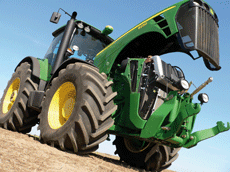
Meeting the rising standards has been a real challenge. For example, switching from Euro 2/Tier II compliance to the Stage 3A/Tier III standard required a 30% cut in NOx levels on top of the 30% reduction required to meet the previous standard.
At the Stage 3A/Tier III level, emissions within the agricultural sector have already been cut by half, but a further 90% reduction in diesel particulates and a 50% cut in NOx is required to meet Euro 3B/Interim Tier 4 rules, which come into effect from 2011, with yet further cuts required by the final step, which begins to take effect in 2014.
Although all engine manufacturers have been stretched by these demands, those keen on supplying other manufacturers have seen some useful commercial opportunities for supplying those that have abandoned their own engine programmes in favour of buying them in.
New Holland (before its merger with Case) chose Cummins as a partner for new engine design and manufacture, while the Same Deutz-Fahr group turned to Deutz for emissions-compliant power units.
At the same time, Deere, Kubota and even Zetor decided to develop their own engines to meet emissions rules, while Agco and JCB became engine-makers in their own right – Agco acquired SisuDiesel and JCB started a project from scratch.
For its switch from independent to joint-venture engine manufacture, New Holland teamed up with fellow Fiat group company Iveco (which needed new engines for trucks and buses) to get volume and with Cummins to tap into the US diesel engine specialist’s expertise in combustion technology.
The European Engine Alliance, formed in 1996, had an initial budget of £150m to design a new family of four- and six-cylinder engines that could be developed to meet expected emissions requirements. The project led to a new assembly plant being built near Turin.
The partnership with Cummins ends this year. In future, the EEA operation will operate as part of the Fiat group’s FPT Powertrain Technologies business unit, which also takes in Iveco’s off-highway engines interests.
Last year, FPT supplied CNH Global with 95,950 engines from 70hp to 240hp for installation in Case IH and New Holland machines, as well as selling six-cylinder engines to Landini and McCormick, both part of the Italian Argo Group.
Although the EEA factory initially supplied Cummins with the core structure of the QSB four- and six-cylinder engines assembled at its Darlington plant in Co Durham, the Euro 3/Tier III version used in today’s JCB Fastracs has a different, Cummins-built block.
Cummins has had most success in the agricultural sector supplying big six-cylinder engines to North American plants building large tractors and harvesters.
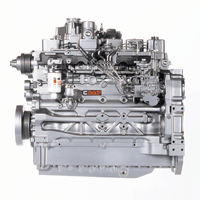
In 1980, it formed Consolidated Diesel Corporation as a 50:50 joint venture with Case to produce four- and six-cylinder engines for combines, cotton pickers, construction machines and the Case IH Maxxum and Magnum tractors.
As with the EEA project, that partnership is being dissolved this year but with Cummins becoming the sole owner, as the Fiat group becomes increasingly reliant on its own engines.
Today, about 18% of the diesel engines built by Cummins are installed in agricultural and construction vehicles. In Europe, it supplies Agco’s Beauvais plant with four- and six-cylinder engines that are installed in Challenger wheeled tractors for North America and east European markets.
It also still supplies JCB’s Cheadle plant with QSB6.7 and QSC8.3 six-cylinder engines for use in Fastrac tractors, wheeled loaders and other larger-scale construction machines.
JCB now builds its own four-cylinder engines, bucking the outsourcing trend with its £80m four-cylinder diesel engine project.
The JCB 444 Dieselmax, built at a new facility in Derbyshire, goes into all JCB backhoe-loaders and most of the company’s telescopic handlers.
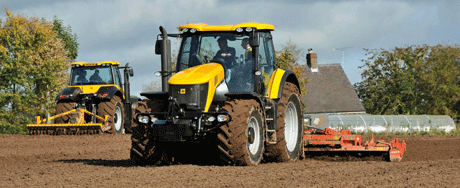
Industry pundits question the viability of producing an in-house engine. But JCB says an output of about 70,000 vehicles a year – most of them powered by four-cylinder engines – together with the use of bought-in components and a highly-automated assembly line makes it worth doing, especially now that bought-in engines are costlier than they used to be, thanks to the emissions rules.
The Same Deutz-Fahr Group turned to independent engine supplier Deutz for a solution to its power needs, having decided it would be too costly to develop the Same 1000 Series four- and six-cylinder engine family to meet the new emissions standards.
It also seized the chance presented by an ailing share price to become the German engine builder’s biggest shareholder. This was a shrewd move – not only does SDF now have board-level influence, but it has seen the value of its investment increase as the Deutz company’s economic performance has been turned around.
Last year, Deutz supplied 34,636 engines for agricultural equipment – about 12% of total production – with SDF using the power units in all but its smallest Deutz-Fahr, Same, Lamborghini and Hurlimann tractors.
Agco’s Fendt operation has also switched entirely to Deutz engines, having dropped the MAN units from its 900 Vario tractors.
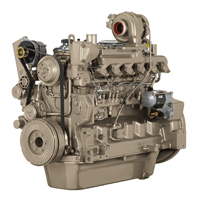
As well as fitting its own engines into its tractors and machinery, Deere also supplies engines through its Deere Power Systems arm to a number of other makers.
Claas Arion and Axion models use the 4.5- and 6.8-litre PowerTech Plus diesels, but in a surprise move, the Axos range that supersedes the Ceres has switched to the 4.4-litre Perkins 1104-44 Series engine.
The UK maker’s business with JCB, Landini, Massey Ferguson and McCormick has been eroded in recent years.
It still has a strong position in the market, however, supplying parent company Caterpillar with four-cylinder engines as well as numerous four- and six-cylinder power units delivered to farming and construction vehicle manufacturers around the world.
Perkins has also just announced that its Tier-4-compliant 1200 series engines will run to 302hp and will include new seven-litre engines with EGR, ultra-high-pressure fuel delivery and two-stage turbocharging.
Although former owner Massey Ferguson still uses Perkins power for most of its sub-150hp tractors, Finnish-made Sisu diesels are creeping further down the range as Agco capitalises on its in-house engine supplier.
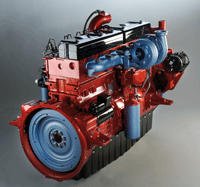
Apart from being installed in all Valtra tractors, most six-cylinder MF tractors and all Massey Ferguson combines, the engines are also used in Challenger wheeled tractors and the CVT tractors from Case IH and New Holland.
Sisu Diesel produces 28,000 engines for European farm and forestry equipment applications. It also announced last month that it is to set up a tractor plant with Russian firm Concern Tractor Plants that will produce 20,000 engines a year, bringing Sisu’s total production close to 97,000 units by 2012.

